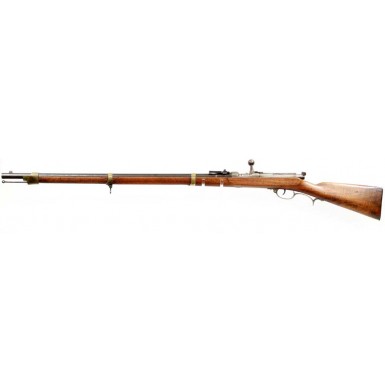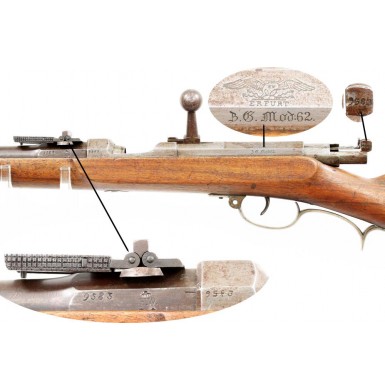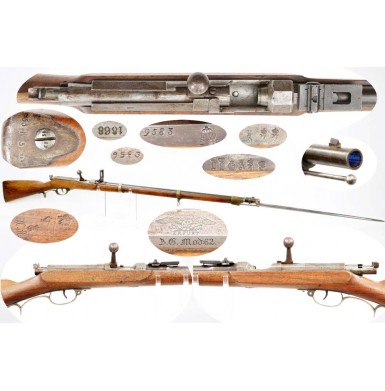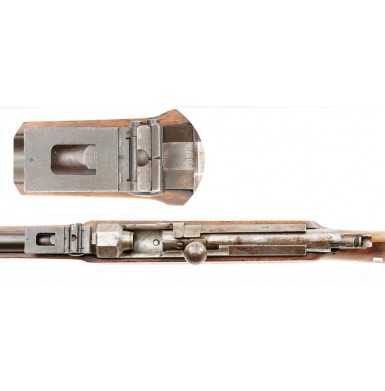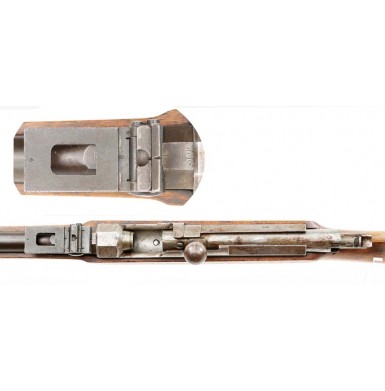Dreyse M62 Needle Rifle & Bayonet - Unit Marked
- Product Code: FLA-3281-SOLD
- Availability: Out Of Stock
-
$1.00
In 1836 Johann Nikolaus Dreyse (later honored with a title making him Johann Nikolaus von Dreyse) revolutionized the world of military firearms by submitting his bolt action “needle rifle” to the Prussian military for testing and trials. Dreyse was born in SŒMMERDA, Prussia in 1787, and probably developed an interest in making and building things from his father, who was a blacksmith. From 1809-1814 Dreyse worked for the famous Swiss gunmaker Jean-Samuel Pauly, who operated a gun manufactory in Paris. It was there that Dreyse was probably exposed to the concept of breechloading rifles, as Pauly conducted a number of experiments during that time of various breechloading designs. Dreyse returned to Prussia after working for Pauly, and established a percussion cap manufactory in SŒMMERDA in 1824. Dreyse was certainly on the cutting edge of the firearms business at the time, as the percussion cap was still nearly two decades from somewhat universal, worldwide acceptance. It was at this time that Dreyse started to experiment with self-contained paper cartridges. While paper cartridges that contained black powder and projectiles had been around for almost two centuries, they all required the use of an external ignition system; either powder in the pan of a flintlock or a percussion cap on the cone (nipple) of the gun. Dreyse developed a paper cartridge that contained not only the bullet and the powder, but also the percussion cap, which was situated at the bottom of the bullet, above the powder charge. Placing the cap in that location allowed the base of the bullet to act as the anvil upon which the cap could be detonated when it was struck. Dreyse also developed a long, needle-like pin that was tensioned by a coiled spring, and was effectively the first widely produced firing pin design. Initially Dreyse applied these new developments to a muzzle loading firearm design, with the novelty being the self-contained paper cartridge and the needle fire ignition system. This did not, however, provide significant advantages over conventional percussion muzzle loading arms. Then in 1836 he applied the same concepts to his newly designed breechloading rifle that was bolt actuated. This was revolutionary, as it made the gun very fast to load and allowed it to be easily loaded while the shooter was prone, concealed or even on horseback. He submitted his design to the Prussian military, and it was accepted in December of 1840. In 1841 the new infantry rifle was designated the Leichte Perscussions-Gewehr M-1841. The name “Light Percussion Rifle M-1841” was meant to conceal the revolutionary nature of the new firearm, but by 1855 the term Zündnadelgewehr (Needle Gun) was in general use within the Prussian military. The rifle was a 15.4mm (about .61 caliber), single shot, bolt-action breechloader that looked rather like the previous generations of Prussian muzzle loading flintlock and percussion muskets. In fact, at first glance the M-1841 looked rather like a bolt action M-1809 “Potsdam” musket, as it retained the breech stock, brass barrel bands and general silhouette of the musket. In place of the usual percussion lock there was only a stock flat, reminiscent of the off-side of a percussion musket. The new M-1841 was somewhat shorter and lighter than its percussion predecessor with a 33 ““ barrel and a 54” overall length, which had a 41 ““ barrel and was 56 ““ in overall length. The new rifle could fire 10 to 12 rounds per minute, which was an astounding rate of fire for the time. The muzzle velocity was about 1,000 ft/s and the rifle had an effective range of about 600 yards. This was somewhat shy of the 1,000 yards that the best muzzle loading rifle musket designs of the mid-19th century were capable of. The primary issue was poor gas sealing at the breech, allowing the escape of gasses at that location and reducing the chamber presser and projectile velocity. The other major drawback was the fact that the firing needle had to be very long to reach the primer deep within the paper cartridge, at the base of the projectile. This lead to issues with needle breakage and required that the soldiers to carry spare needles with them, as well as to be capable of disassembling the bolt system in the field to replace a broken needle. In an attempt to improve the quality of the M-1841, and potentially reduced gas leakage, a new version, the M-1862, was adopted in that year. The M-1861 retained the 15.4mm caliber, broad 4-groove rifling and the needle fire bolt-action system, but was produced with improved tolerances in an attempt to limit leakage and improve interchangeability. The new rifle also had a slightly shorter, 32 ““ barrel and the “short butt variant” was only 52 ““ in overall length. The improved version was only slightly better in terms of gas leakage. Despite the short comings of limited range, gas leakage and needle durability, the amazing rate of fire made the Zündnadelgewehr a fearsome weapon to be encountered by an enemy armed with conventional muzzle loading muskets. The Prussians used the Zündnadelgewehr (both M41s and M62s) with devastating effectiveness against the Austrian infantry during the Austro-Prussian War of 1866, where observers commented on the fact that a prone Prussian infantryman could fire 5 rounds in the time it took a standing Austrian infantryman to load his rifle one time. During the Franco-Prussian War (1870-1871) the superiority of the smaller caliber French M-1866 Chassepot Rifle with its obturating bolt was quickly obvious to the Prussian military. The Chassepot’s bullet was fired at a higher pressure and less gas leakage, resulting in greater velocity and range. Thus, a system of modification of existing stocks M41 and M62 rifles began. The alteration, known as the Beck Conversion, required that a new bolt head be installed on the face of the bolt. This new bolt head was attached with a large screw through the side of the bolt, which is easily visible from the exterior. Additionally, a leather washer was placed between the new bolt head and bolt body, creating an obturator. When the rifle was fired the gas pressure pushed the new bolt head back and expanded the leather washer against the chamber walls, increasing the gas seal, similar to the obturator found in the French Chassepot rifle. This reduced leakage and increased bullet velocity. The Beck system also used modified ammunition with the bullet seated deeper in the papier-mâché” sabot, allowing the use of a slightly shorter needle. Nearly every needle rifle found today has the Beck Conversion to the bolt. The end of the Franco-Prussian was quickly followed by the adoption of the new Mauser designed M71 bolt action rifle, the first self-contained metallic cartridge rifle to be adopted by the Prussian military. As a result, the M41 and M62 needle rifles were quickly relegated to secondary service with the Landwehr (German secondary reserve troops or militia) and was wholly obsolete very quickly. However, the Zündnadelgewehr was a groundbreaking weapon that served Prussia’s front line troops for three decades and remains the first bolt action rifle to see universal issue to the military of any country.
Offered here is a wonderful example of a Infanterie-Gewehr M 1862, or a M62 Zündnadelgewehr (M-1862 Needle Rifle). The rifle remains in VERY FINE overall condition and is all complete and correct except for a single missing sling swivel, the fragile, (often missing or broken) needle and the leather obturating washer. The rifle also includes a correct Model 1862 socket bayonet, more than making up for the missing needle in terms of value. The rifle was manufactured at the Prussian national arsenal at Erfurt and is marked with the spread-winged eagle of King Wilhelm I on the upper left angled flat of the receiver, over the word ERFURT. On the left flat, below the arsenal mark is the model B G Mod:62 in Germanic script, which indicates that this is the Infantry Rifle Model 1862, known colloquially as the Zündnadelgewehr or “needle rifle”. The upper angled receiver flat on the right side is marked with the year of manufacture, 1868. The rifle is serial number 9583 and the full serial number is present on the left forward portion of the receiver and on the left reward portion of the barrel where it meets the receiver. The barrel additionally bear a (CROWN) / FW proof mark on the left side and is marked Stahl (steel) on top. The full serial number appears on almost every piece of iron or steel on the rifle, including the rear side of the bolt, the cocking piece, both the rear sight leaves the toe of the buttplate and all the furniture screw heads. The brass furniture (barrel bands and triggerguard) are not numbered, but all bear Prussian inspection marks. The top of the iron buttplate is unit marked 55 R 5 204, indicating that the rifle was issued to the 55th Infantry Regiment, 5th Company, Weapon Number 204. This 55th designation indicates that rifle was issued to the 6th Westphalian Infantry regiment, No. 55, which was assigned to the 26th Brigade of the VII Army Corps during the Franco-Prussian War. The VII Corps was commanded by General Alexander Friedrich Adolf Heinrich von Zastrow who had served gallantly during the Austro-Prussian War in 1866 and lead the VII Corps in the battles of Spicheren, Gravelotte during the Franco-Prussian War, as well as at the sieges of Metz, Thionville, Montmédy, and Mézières. A plethora of Prussian inspection and proof marks are clearly stamped on the right side of the receiver and barrel. Numerous inspection marks are present in the stock as well, both underneath and on the obverse butt. In addition to the (CROWN) / FW and inspection marks, the butt is also marked K A, indicating “Kurze Anschlag” or “short butt”. The longer butt version is marked “LA” for “long butt”. The rifle retains about 50% of its original browned finish on the barrel, which has faded, dulled and oxidized to form an even, smooth plum-brown patina. Some brighter original finish is present under the barrel bands, where it has been protected. The receiver and buttplate remain “in the white”, but both show evenly scattered surface oxidation and discoloration, the buttplate in particular. The metal of the rifle remains almost entirely smooth, with only some lightly scattered pinpricking along the length of the barrel and around the receiver. Some very light pitting is present around the hexagonal chamber of the receiver, at the muzzle and on the buttplate. The bore of the rifle is in VERY FINE condition, and remains brilliant and bright for almost its entire length, with extremely crisp four-groove rifling. Only the last couple of inches nearest the muzzle show any darkness or corrosion and potential light pitting, and a good scrubbing might clean up this area and show no real pitting is present. The bolt action mechanism functions correctly, as does the cocking mechanism. The bolt shows the Beck bolt face conversion that nearly all Zündnadelgewehr s underwent during the late 1860s and early 1870s in an attempt to improve the gas sealing properties of the design. As noted earlier, the only condition issue worth noting in the mechanism is the absence of the needle, and the never present leather bolt washer. However, replacement needles are available. The rifle retains its original rear sight with the fixed block, small folding leaf and long range adjustable folding leaf. The sight retains traces of its original blued finish, scattered on the metal which has a dark, smoky gray patina. The original front sight/bayonet lug is present as well. The original cleaning rod is present in the channel under barrel and appears to be full length but is tightly secured in the channel and I could not remove it from the stock. The brass furniture has a wonderful, untouched dark patina with some greenish-brown tones and like the balance of the rifle shows no indication of having been cleaned. The original upper sling swivel is in place on the middle barrel band, but the lower swivel is missing from the triggerguard bow. The stock of the rifle is in about FINE overall condition and shows no indication of having been sanded or cleaned. Nearly all the inspection marks in the wood remain extremely crisp and those that show any wear are the result of actual handling and use, not sanding. The reverse of the stock is stamped 546 at the upper edge, near the buttplate tang. This appears to be some sort of rack number, rather than stock number. As every screw head retains the matching serial number 9583 I cannot for a minute believe that all of the screws were transferred to a replacement stock were one needed, without losing at least one. The wear and the condition of the stock match the rifle perfectly and I am sure they have been together since the period of use. The stock does have a couple of minor condition issues worth noting. There is a small angled crack, less than 1” in length on the reverse just above the middle barrel band at the stock to barrel joint. There is also a small sliver of wood missing on the upper edge of the stock on the obverse, between the lower and middle barrel bands. Otherwise the stock shows only the usual assortment of scattered bumps, dings and surface mars expected to found on any 19th century military rifle. The stock is amazingly quite crisp and sharp for its age and the use it certainly saw during the Franco-Prussian War.
The accompanying Model 1862 Socket Bayonet is in about FINE condition as well. The bayonet fits the rifle perfectly and its patina matches the rifle well. The bayonet has a dull pewter base color with a mottled patina of darker surface oxidation. The blade is mostly smooth with some scattered pinpricking and a few patches of very light pitting, mostly on the underside of the blade. The shank of the bayonet is number 1688, so it is not “matched” to the rifle. The ricasso shows the usual assortment of Prussian inspection marks, all of which are deeply and crisply stamped. The blade is full-length and unaltered. The socket retains its original locking ring, which rotates smoothly and operates exactly as it should.
The rifle and bayonet are a really fine condition example of the arms carried by a front-line Germanic states infantryman during the Franco-Prussian War. The rifle is nicely unit marked on the butt and more history about that unit and its exploits during the Franco-Prussian War can certainly be researcher. The rifle and bayonet are a very attractive pair that display wonderfully together and will be a wonderful addition to any serious collection of Prussian military arms, Franco-Prussian War weapons or even a collection of German military rifles, as the Zündnadelgewehr was the first “modern”, bolt action rifle to see service with German military units. This is a set you will be very proud to own and to add to your collection.
SOLD



